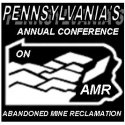Collection of AMD Iron Oxide Deposits, Inventory and Analyses of AMD Discharges in Northeastern Pennsylvania for Resource Recovery Potential (*)
Robert E. Hughes (**) and Jeffrey M. Frank (***)
Abstract: Mr. Bob Hedin, a leading expert in the field of acid mine drainage (AMD) remediation, formed a new company in 2000, Iron Oxide Recovery, Inc. (IOR), to focus on research and development related to the recovery process of iron oxide deposits. His company, Hedin Environmental, has already received a patent for a system that produces pigment-grade iron oxide (EnvironOxide [tm] pigment) recovered from AMD in Western PA. Because of the prevalence of iron precipitate in the streams in the anthracite and bituminous coal regions of Eastern Pennsylvania, the Eastern Coalition for Abandond Mine Reclamation (EPCAMR) is working together with IOR on an iron oxide resource recovery project. Mr. Jeffrey Frank is currently sampling many alkaline AMD discharges that are loaded with iron precipitate, either on the stream bottom or within treatment systems operated or maintained either by the Commonwealth of Pennsylvania or community watershed associations, to gather samples of the “iron (precipitate) sludge” for analysis of its purity (iron oxide pigment %) to see if it can be marketed as a resource in conjunction with IOR. In addition to the potential for resource extraction, the results of this field data are being compiled in a Microsoft Access GIS database utilizing ArcGIS 9.0 and a hand-held GPS Magellan Meridian Platinum Series Unit in order to help better visualize where these AMD problem areas are within EPCAMR’s region of interest. For more information about Using GIS Technology for Abandoned Mine Reclamation please visit the Geospatial Conference Website

Could IORR – Iron Oxide Resource Recovery be a link to long term Treatment?
The Eastern Pennsylvania Coalition for Abandoned Mine Reclamation (EPCAMR) currently has a partnership with Office of Surface Mining, Reclamation and Enforcement (OSM) through its Watershed Internship program and has been a sponsoring organization for the internship program for the last 8 years. EPCAMR is also sponsoring a year-long OSM/Volunteers in Service Training in America (VISTA) Watershed Outreach Coordinator beginning in the Fall of 2004, that is also funded partially through the OSM and the Corporation for National Service. OSM/VISTA have a unique National Watershed Team that is working in coal communities throughout Appalachia to assist community groups, local governments, and under-served populations to deal with reclaiming abandoned mine lands, restoring streams impacted by AMD, and building community support for education and outreach programs in watersheds that have been impacted by AMD for decades. Both positions will allow EPCAMR, over the next year, to complete an extensive compilation of the estimated volumetric amount (tons) of iron oxide precipitate that typically coats thousands of miles of streams in PA. These streams are impacted by AMD that emanate from underground abandoned mine features in the Bituminous Coal Fields of the Northern Tier and the Anthracite Coal Fields of Northeastern PA. The results of the collection of this field data is compiled in a Microsoft Access GIS database utilizing ArcGIS 9.0 and a hand-held GPS Magellan Meridian Platinum Series Unit.
EPCAMR staff are working collectively, in partnership with many organizations, including the OSM, Hedin Environmental, the Luzerne Conservation District, Earth Conservancy, and the PA DEP Bureau of Watershed Management-Section 319 PG, PA DEP Bureau of Abandoned Mine Reclamation, US EPA Region III, and the PA DEP Pottsville District Mining Office. Mr. Frank is currently sampling many alkaline AMD discharges that are loaded with iron precipitate, either on the stream bottom or within treatment systems operated or maintained either by the Commonwealth of Pennsylvania or community watershed associations, to gather samples of the “iron (precipitate) sludge” for analysis of its purity (iron oxide pigment %) to see if it can be marketed as a resource. EPCAMR is currently working with over 65 community watershed organizations and 16 Conservation Districts to assess the AMD discharges found in their respective communities across Northeastern PA. This iron oxide resource recovery project is the first of its kind to map sites and determine AMD constituents with the goal of promoting private industry to re-use the iron oxide pigment, in paint, stain, concrete, chalk, ceramics, wood chips, sand, glass, and other commercial avenues in Northeastern PA. EPCAMR has devised a field data collection form in a Microsoft Access database that can be duplicated in other watersheds for the same use. The form was developed in a Microsoft Access database so that EPCAMR can join it to existing State databases with other information on abandoned mine discharges, such as those monitored by the PA DEP Bureau of Abandoned Mine Reclamation and the Pottsville and Moshannon District Mining Offices, in relation to flow, water sampling, abandoned mine land features, qualitative field assessment information, and other trace metal analyses. EPCAMR’s form is a very qualitative analysis of the discharges that are in the field at each of the abandoned mine land sites and contains some quantitative information on estimates of the volume of iron oxide precipitate that is either being produced by a discharge or can be potentially recovered.
No such inventory and exhaustive collection and analysis of AMD discharges of iron oxide deposits has ever been compiled before in Eastern PA. EPCAMR is the first regional non-profit organization to pioneer this project to see if there are ways to economically recover various metal oxides from AMD discharges, and or from AMD Passive Treatment Systems in Eastern PA. EPCAMR is hopeful that the successful completion of this project will assist in the development of a new resource recovery market for AMD remediation in PA that will eventually lower the costs of maintaining passive treatment systems in Northeastern PA, by developing a return on the investment of the market potential for the iron oxide deposits that plague 2400 miles of streams in PA. This GIS/GPS Project can turn our biggest source of non-point source pollution into a win-win for the environment and the economy of many of the already depressed, urban, disturbed watersheds and coal country communities that EPCAMR works in to reclaim abandoned mine lands and to remediate streams and rivers impacted by AMD.
Hedin Environmental has already received a patent for a system that produces pigment-grade iron oxide (EnvironOxide [tm] pigment) recovered from AMD in Western PA. Mr. Bob Hedin, a leading expert in the field of AMD remediation, formed a new company in 2000, Iron Oxide Recovery, Inc. (IOR), to focus on research and development related to the recovery process of iron oxide deposits. The final completion of this project, in partnership with the Office of Surface Mining, the Corporation for National Service, the Earth Conservancy, EPA Region III, EPCAMR, and the OSM/VISTA National Watershed Team, along with the other PA State Agencies, could lead to application of the methods used here throughout the country.
(*) Paper was presented at the 2004 Advanced Integration of Geospatial Technologies in Mining and Reclamation, December 7 – 9, 2004, Atlanta, GA.
(**) Robert E. Hughes is the Regional Coordinator of the Eastern PA Coalition for Abandoned Mine Reclamation, Luzerne Conservation District, 485 Smith Pond Road, Shavertown, PA 18708
(***) Jeffrey M. Frank is a Watershed Mine Drainage Specialist with the Eastern PA Coalition for Abandoned Mine Reclamation, Luzerne Conservation District, 485 Smith Pond Road, Shavertown, PA 18708
EPCAMR Region Watershed Groups and Municipalities: If you are interested in showing us your AMD discharge for evaluation in this project please contact Robert Hughes or Jeffrey Frank. We are looking for discharges that have a pH of 5.0 or more and contain atleast 5.0 mg/L of Iron.











